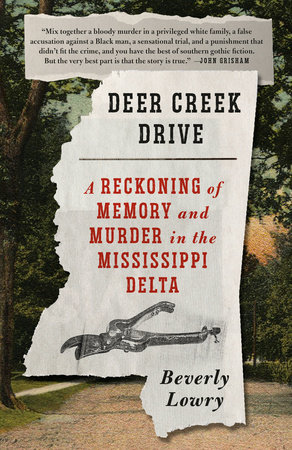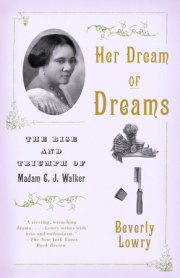Looking Back
You’d think by now people would have forgotten or perhaps decided simply to let go of the memory of what happened in the Mississippi Delta town of Leland in the early afternoon of November 17, 1948. But nobody has. Even people too young to remember know about it. They’ve seen clippings pasted in old scrapbooks or heard the story (which did not, by the way, end that year or the next but went on and on, one of those stories that because people love to tell it keeps starting over). Although some local residents still refuse to engage, even briefly, in a discussion of the matter, there are those who would—if you went to Leland—gladly point out the house where it happened—still standing, freshly painted perfectly white, lawn exquisitely maintained. They might even be willing to tell you exactly where in the house the sixty-eight-year-old “society matron” was attacked, first in the enclosed back porch, and then dragged on a small rug into her own bathroom, where she, or, more than likely, her body, ended up: facedown, her daughter said, in her own blood soup, the crown of her head against the tub, beside which sat an ordinary three-legged wooden stool. And between the stool and her head, the gleaming nightmare weapon washed and wiped clean of prints and gore.
That it happened was shocking enough on its own. But there? In that neighborhood?
Until that year, both of these women, the society-matron mother and the socialite daughter, had lived pretty much their whole lives on this street, which—it is important to note—was and still is the most desirable in town, the street about which locals say, “If you want to get to heaven, you have to live on Deer Creek Drive.”
Or, as some would say, simply “the Drive.”
If by happenstance you did find yourself in Leland standing before the murder house, you might then want to check out the house where the dead woman’s daughter lived with her cotton broker husband and two young daughters: a mere three houses away down the Drive, north toward Stoneville. You could walk there in minutes, noting as you went, thanks in great measure to the Leland Garden Club, the beauty of the surroundings: the meandering creek to your left and on its high, sloping banks the oak and sycamore trees, the occasional surviving sweet gum, the crepe myrtle and pecan, the azalea and rosebushes, the park benches, the well-fed families of proprietary ducks.
That the two women’s homes were situated on what some Leland families consider the “wrong” side of the creek should also be noted. It is, of course, a measure of small-town snobbery that there exists, to some, a bad side of the best street in town, but the distinction is also significant in terms of current property values. Houses on South Deer Creek Drive, according to a longtime realtor and lifelong resident, command a higher price. Asked why this was, she answered with a sigh, as if the reason should have been obvious. Because, she said, “Black people live on the south side.”
Close to? Or on?
These days? Both.
It was 2018. I’d returned to the Delta to participate in the annual Hot Tamale Festival, which took place in downtown Greenville. The realtor was driving me around Leland, pointing out places of historical interest, including a museum devoted to Kermit the Frog and his creator, the puppeteer Jim Henson, surely Leland’s best-known native, more famous even than the bluesmen Son Thomas and Johnny Winter. She’d promised to get me into the murder house, which she’d personally sold five times since the killing, but when we drove there and she went inside to ask, the current residents told her no way.
Without a doubt, anybody who knows how and where, on the very day she’d been released from a weeklong stay in the hospital, Idella Stovall Long Thompson was murdered—anybody, that is, willing to remember and say so—could also let you in on the most important part of the story: the identity of the person who was eventually arrested, tried on a first-degree murder charge, convicted, and sent to Parchman, Mississippi’s infamous state prison, for life. This particular detail is why a lot of Leland people want to keep the story under wraps. And while some of those who refuse to talk are relatives of the two women or members of the same social class, not all are. A furniture salesman told a friend of mine that if I was hoping to hear what people had to say about that, I “might as well go on back home.” Because, he said, “we’re not going to talk about it,” with no indication who he specifically meant by “we.” Leland’s small enough—its population barely five thousand in 1948, less than that now—to come together like that, to automatically clam up, close ranks, do the zipper thing, running pinched thumb and index finger across their lips as if to lock the information inside.
I know the story, they’re saying, but I’m not telling. Especially not to an outsider like you.
Greenville, where I grew up, is only nine miles away, but I’d left years before and had never lived in Leland, and so there were lifelong residents who felt justified, if not obliged, to tell me to go on back to Texas and leave this thing alone. And then shut the door in my face.
. . . .
At the time of the murder, however, the news spread fast. Leland was practically a suburb of Greenville, and telephone service still depended on the “Number, please” request of the switchboard operators, the working women whose job was to put calls through and who, as a consequence, often heard important news first. And sometimes they repeated what they’d eavesdropped on, and maybe the person or persons they shared the news with then phoned somebody else, and so on. Also, once the Leland police chief followed through on his sworn duty and called the Washington County sheriff over in Greenville to let him know what had happened within his jurisdiction, the sheriff had to make calls of his own before heading east on Mississippi State Highway 82 to the crime scene.
One “Number, please” led to the next. And so we all found out one way or another, if not that afternoon then certainly by the next morning when the November 18 issue of the Greenville Delta Democrat-Times arrived, bearing what, in retrospect, seems an oddly worded banner headline: “Search Continues in Leland Slaying.” As if the murder itself had become old news. And in some ways it had because we already knew about it, including who the victim was, who’d been at the crime scene, and who the eyewitness said had done it. Which meant the real up-to-the-minute news had moved from the event itself to its follow-up. The search.
Beneath the headline was a more straightforward subhead: “Mrs. J. W. Thompson Killed with Shears. Rites to Be Friday.” The slain woman was described as the widow of the prominent Delta planter and former Mississippi Levee Board chairman J. W. Thompson, whose daughter the forty-two-year-old Ruth Dickins had reportedly surprised the killer, a man she described as a young, slightly built, dark-skinned Negro she didn’t know. She was coming, she said, into her mother’s home and didn’t see the man right away, and before she knew it, he had slammed into her out of, it seemed, nowhere. They tussled and she wasn’t sure how, but she managed to wrestle the weapon from him. After that he fled. Out the back door, she assumed.
“Ruth,” a family relative told me. Nobody called her Mrs. Dickins, except maybe servants and children, many of whom addressed her in the southern manner as Miss Ruth. And she wasn’t a “socialite” as the papers said. She was, her second or so cousin swore, as plain as an old shoe.
As if that mattered. As if social status in the Mississippi Delta came not from ancestry but personality and character.
. . . .
I was a big reader, but doubt I personally read the paper that next morning. But certainly my parents did. And unquestionably they would have talked about what was splashed all over the front page because it was a story not about strangers living in a whole other part of the country but about known people, members of a top-tier family. Being a listening, watching, imagining kind of girl, I would have paid attention, the same as, in all likelihood, every other girl my age, ten going on eleven being an age when female children are beginning to scarf up whatever information adults have been keeping from them, especially details of the most lurid, the worst things that have happened or still might.
But I can’t honestly say I remember much from that particular day. Things had to spin out a little further. A little more time had to pass. More news reported, discussed, wondered at before imagination could take hold and sink deeply enough in to make forgetting out of the question.
Once the AP had wired the story all over the country, other newspapers covered it that same day, including the Chicago Tribune (“Widow of Planter Killed by Intruder”), the Austin American-Statesman (“Planter’s Widow Hacked to Death”), The Montgomery Advertiser (“Prominent White Woman Slain”), the Greenwood, Mississippi, Commonwealth (“Leland Woman Is Killed by Negro”). And others, all emphasizing race, class, and shock value.
While splashy, unlikely murders tend to encourage long memories, this one was like no other, and in our part of Mississippi—that egg-shaped patch of ridiculously rich alluvial soil we called the Delta—nobody talked about anything else that whole fall and especially the next spring and summer when the trial provided the grisly details.
. . . .
My memory of Greenville attaches itself to houses: where we lived when certain things happened, how old I was each time we had to move from one address to another, whether it was the time I broke my arm playing Crack the Whip the first day I went roller-skating in Strange Park and didn’t know enough to avoid taking the end position, or the day my brother David blasted his face open by tearing spent firecrackers apart and lighting them, not knowing one of them was alive, or the time when the panel truck from Tatum Music Company came to take away my mother’s beloved Baldwin Acrosonic piano for nonpayment. We mark time mostly, I think, by events. I order my and my family’s Greenville life according to which house we were living in at the time. In our fourteen-year residency, there were seven, only one of which—the bungalow at the corner of Cedar and Manilla—we left by choice.
When my first novel, Come Back, Lolly Ray, was published in 1977, I hadn’t lived in Greenville for more than twenty years. I’d gone back maybe twice during that time, brief overnight stays ending in a quick getaway before I ran into somebody who might remember the deepening financial and legal troubles that encouraged my family, the Feys, to skip town and not come back.
I never planned or even wanted to set a book in Mississippi. There was the burden of the state’s literary past—Faulkner and the rest—plus I’d moved, I thought, for good. I wanted the past to stay where it was and believed that whatever I wrote would reflect the person I’d become, living in Manhattan, learning how to eat an artichoke, combing my hair across my forehead in a dramatic slant, like Delphine Seyrig in Last Year at Marienbad. But the past can be a nag. And sometimes a book knows what it is before the writer has a clue, including who’s going to be in it and where it’ll take place.
I renamed my fictional town Eunola and never said what state it was in or even which river dead-ended the main street of town. But Greenville knew. The opening line was like a secret whispered into their hometown ears: “The sun and river were to the west, back over their shoulders on the other side of the levee. The main street of town—along which they waited, impatiently—dead-ended there, at the foot of the levee.”
Who among locals didn’t nail it down? They knew I’d grown up there and that what I was describing was, absolutely and without a doubt, downtown Greenville, Mississippi. Within another page or so they’d have figured out other details.
Friday. Autumn. Late afternoon. The courthouse. Washington Avenue just over the railroad tracks where the street makes a sharp jag to the left toward the levee. Majorettes, marching band, drum major, special twirlers, cheerleaders. What else but the parade preceding the high point of our week: that night’s high school football game?
That book wasn’t about my life, and neither is this one. But both emerge from me. And here I am at this stage of my life, these seventy years later, remembering things that took hold of me then and still refuse to let go.
The story of Ruth Dickins, the murder of her mother, and what happened afterward.
The story of a girl who could not stop wanting what she couldn’t have.
And the hot tamale region that birthed us both.
November 17, 1948
The first police officers to arrive on the scene were the Leland chief of police, Frank P. Aldridge, and Phillip P. “Pink” Gorman, one of only three regulars on the Leland police force. Aldridge wasn’t feeling well, having been released from the hospital after surgery only the day before, in addition to which, barely four months earlier, he’d undergone three separate surgical procedures in one day. Although barely able to get around, he nonetheless managed to pull himself together and get to work. He was downtown on a Third Street sidewalk not far from the police telephone box when, middle of the afternoon, it rang.
Leland was one of those quiet, small towns news reporters like to call “sleepy.” Because nothing much of a criminal nature happened there beyond the usual petty crimes and traffic violations, that phone didn’t ring too often. With no idea how his life was about to be jiggered, Aldridge answered and, once he’d heard the message, told Gorman to go get the police car—there was only one—Mrs. Thompson had been murdered.
No need to identify the victim further. Idella Long Thompson’s family had lived on the Drive since 1902. They owned acreage east of town. There was also the matter of the Thompson husband, all those years ago. Frank was chief at that time too. The family tried to keep the details of what had happened hush-hush, but people got wind of it quick. Nobody didn’t know who the Thompsons were.
. . . .
The call had come from one of Leland’s most respected doctors, the co-founder of the Witte Clinic and Hospital—where both Aldridge and Mrs. Thompson had been hospitalized—Dr. Kinney Lyght Witte (pronounced “Witty”), affectionately known throughout the town as simply Doc. A noted horseman, Doc was also the murder victim’s brother-in-law, having been married to her baby sister, Johnie, for forty years.
Copyright © 2022 by Beverly Lowry. All rights reserved. No part of this excerpt may be reproduced or reprinted without permission in writing from the publisher.











